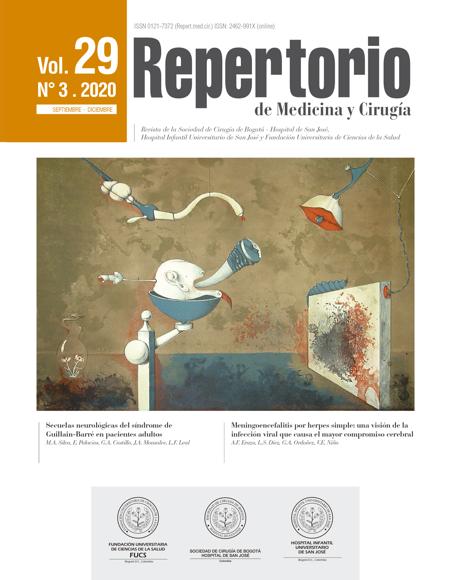Factors associated with mortality in trauma patients admitted to the emergency service
Factores que impactan en la mortalidad de los pacientes con trauma que ingresan al servicio de urgencias
How to Cite
Download Citation
![]()
![]()

Show authors biography
Introduction: traumatic injury is one of the leading causes of death worldwide. Gaining knowledge on this topic is the basis for developing strategies to decrease mortality and complications, improving the quality of care and providing a timely response at the emergency services. Objective: to determine the factors associated with mortality in trauma patients admitted to the emergency service of San José and Infantil Universitario de San José hospitals between 2012 and 2018. Methods: a case and control study including 462 patients, 47 cases and 415 controls, collected in a clinical record review and analyzed using a logistic regression model. Results: we analyzed 462 trauma patients. Median age was 33 (IQR 25-50), and 70.78% (n= 327) were males. We observed the relationship between age OR 1.035 (CI 95% 1.002- 10.70), systolic blood pressure OR 0.96 (CI 95% 0.94-0.99) and Glasgow coma score OR 0.55 (CI 95% 0.45-0.67) with mortality. The most frequent cause was cranioencephalic trauma (74.47%) and traffic accidents (44.68%). Conclusions: this study determined there is an association between age, Glasgow coma score and systolic blood pressure with mortality as outcome in trauma patients.
Article visits 1815 | PDF visits 1222
Downloads
- Cortes M C, Acuña R L, Alvarez M F, Alvarez L N. Manejo inicial del politraumatizado. Rev Hosp Clin Univ Chile. 2013;25:206-16. doi: 10.5005/jp-journals-10030-1190 DOI: https://doi.org/10.5354/2735-7996.2014.72791
- Monteverde E, Bosque L, Lartigue B, Macia E, Barbaro C, Ortiz C, et al. Evaluacién de la Nueva Definición de Politrauma en una Cohorte de Pacientes de 10 Hospitales Argentinos. Panamerican Journal of Trauma, Critical Care & Emergency Surgery. 2017;6(3):182-9. DOI: https://doi.org/10.5005/jp-journals-10030-1190
- Ministerio de Salud y Protección Social. Dirección de Epidemiología y demografía. Análisis de situación de salud (ASIS): Colombia, 2017. In: Moreno Segura CM, editor. Colombia: Imprenta Nacional de Colombia; 2018. p. 149.
- Gosselin R, Spiegel D, Coughlin R, Lewis Z. Los traumatismos: el problema sanitario desatendido en los países en desarrollo. Boletín de la Organización Mundial de la Salud. 2009;87:246. doi: 10.2471/BLT.08.052290 DOI: https://doi.org/10.2471/BLT.08.052290
- Rivera-Flores J. El paciente traumatizado ¿Quién debe tratarlo? Rev Mex Anestesiol. 2012;35(1):5-7.
- Graff I, Ghamari S, Schacher S, Glien P, Fimmers R, Baehner T, et al. Improvement of polytrauma management‐quality inspection of a newly introduced course concept. J Eval Clin Pract. 2017;23(6):1381-6. doi: https://doi.org/10.1111/jep.12802 DOI: https://doi.org/10.1111/jep.12802
- Cerón Alate LY, Méndez Hernández J, Candela Rada J. Consideraciones sobre la tríada letal para predecir mortalidad en pacientes con trauma mayor. Repert Med Cir. 2019. doi: https://orcid.org/10.31260/RepertMedCir.01217273.665
- Resolución 8430: Por la cual se establecen las normas científicas, técnicas y administrativas para la investigación en salud., (1993).
- Berroeta AF, Odriozola AF, Alzugaray TG, Fernández AI, Jiménez RE, Morán TS. Estudio epidemiológico autópsico de 784 fallecimientos por traumatismo. Proyecto POLIGUTANIA. . Med Intensiva. 2002;26(10):491–500. DOI: https://doi.org/10.1016/S0210-5691(02)79845-8
- Alberdi F, García I, Atutxa L, Zabarte M. Epidemiologia del trauma grave. Med Intensiva. 2014;38(9):580-8. doi: 10.1016/j.medin.2014.06.012 DOI: https://doi.org/10.1016/j.medin.2014.06.012
- Bhandarkar P, Munivenkatappa A, Roy N, Kumar V, Samudrala V, Kamble J, et al. On-admission blood pressure and pulse rate in trauma patients and their correlation with mortality: Cushing's phenomenon revisited. Int J Crit Illn Inj Sci.2017;7(1):14-7. DOI: https://doi.org/10.4103/2229-5151.201950
- Luna D, Izquierdo M, Perez G, Rodriguez C. Incidencia de traumas por accidentes de tránsito que ingresan al servicio de urgencias del Hospital Universitario Erasmo Meoz, La Clínica Santa Ana Sa,e IPS UNIPAMPLONA. Rev Inbiom. 2017;4(1):34-43.
- García Romero M, Patiño Mesa DA. Trauma vascular de extremidades. Urgentia R Int Med Emergencias. 2015;1(1):60-4.












